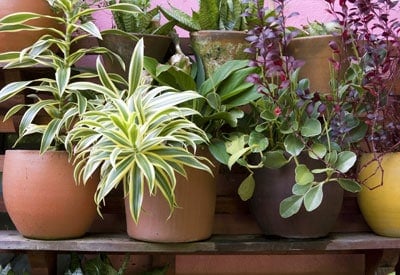When choosing pots for plants … be creative! Try anything from an old boot, to that 16th century Baroque urn you just “had to have.” Just about anything can be used as a pot for plants providing it drains well (roots will rot in soggy soil) and doesn’t get too hot sitting in the sun. If the pot you select doesn’t have enough drainage holes, make sure to drill at least one “good-sized” hole for every gallon of soil used. If you can’t drill or punch holes into a particular planter, you can sometimes work around this, by planting in a separate pot and setting it inside the container you prefer.
When selecting a pot, it’s important to consider the size of the plant — or plants — you will be growing. Yes, size does matter! If the pot is too small, plants will quickly become rootbound and the soil will not be able to hold enough moisture between waterings. Plants that are allowed to dry out, or wilt, will not be productive.

#1 POTTING SOIL
Roots Organics Original Potting Soil
A favorite! This ready to use formula is made with only the finest ingredients.
$27.95Learn moreGet your potted crops off to a great start and keep them healthy with premium quality potting soils. Designed to provide root support, moisture retention and healthy nutrients, these organic mixes will give you maximum results.
On the other hand, if the container is too large, your plants may spend all of their energy on root development and not enough on growth. According to the West Virginia University Extension Service, shallow-rooted crops like lettuce, peppers, herbs and most annuals need a planter at least 6 inches in diameter with an 8-inch soil depth. Larger containers, like bushel baskets and 1/2 whiskey barrels, are perfect for growing tomatoes, cucumbers, pole beans, and most perennials.
Pots and planters are available in many different sizes, shapes, and materials. Whatever type of container you select, consider the area where it will be used and plan accordingly.
Tip: Choose containers in proper proportion to the size of the plant. A container that is about one-third as tall as the plant (measured from the soil line to the highest leaf) often works best.
Terra-Cotta
Available in a variety of shapes and sizes, terra-cotta pots look great just about anywhere and their earthy color will enhance the beauty of almost any plant. Made of a porous clay rich in iron, terra cotta has the ability to “breathe,” which keeps potting soils cool and wicks excess moisture away from plant roots, keeping them healthy. The main problem with using terra cotta, is that it is relatively fragile (watch for hard frosts that can crack containers) and it can dry out quite rapidly, especially in sunny locations.
Note: Some growers prefer glazed terra-cotta pots because they hold water much more effectively.
Plastic
If you’re not concerned about container appearance or have plants that eventually grow to cover the pots they are planted in, plastic is a great choice. Plastic nursery pots are durable, retain moisture well, and are relatively inexpensive. They are also very lightweight, which makes them an excellent choice if you like to re-arrange your gardens.
Do not use black, or dark colored plastic pots if your container garden will be located in a very sunny location. These colors absorb heat and will get very hot, which can damage tender roots. Light colored containers reflect the heat and keep the roots cool.

Concrete
One thing about concrete – it’s heavy! Which makes it ideal for containing large plants or trees that require more support to keep them…well, “contained.” It also has good insulating properties, protecting tender root systems by maintaining a comfortable soil environment. When planting in exposed or public areas, concrete has the added advantage of discouraging anyone from “accidentally” walking off with your prized plants or pots. Concrete planters can be left outside over the winter without harm, which is good since you’re probably not going to want to move them.
Wood
One of the most practical and natural containers for gardening. Wood planters look great, retain water well and are relatively lightweight. When selecting wooden containers, make sure that they are made with rot-resistant woods like cedar or redwood and check for quality construction, since wood will shrink and expand in the elements. Planters made out of pine or other soft-woods can also be used, but should be painted with a non-toxic paint or stain to prevent rot. As for expense, you can easily manufacture a wooden planter in no time with a few nails, some scrap wood and a creative idea.











